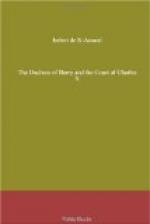The function of the Grand Master of France had as titulary the Duke of Bourbon, Prince of Conde. But this Prince performed his duties only in very rare and solemn circumstances. In fact, the service of the Grand Master of France was directed by the First Steward, the Count of Cosse-Brissac. There were besides four chamberlains of the House, the Count de Rothe, the Marquis of Mondragon, the Count Mesnard de Chousy, the Viscount Hocquart, and several stewards.
The Grand Chamberlain of France was the Prince de Talleyrand. He discharged his functions only on solemn occasions, such as the funeral of Louis XVIII. and the consecration of Charles X. and the arrival of the Duchess of Berry. In fact, the service of the Grand Chamberlain of France was directed by one of the first gentlemen of the chamber. They were four in number,—the Duke d’Aumont, the Duke of Duras, the Duke of Blacas, the Duke Charles de Damas,—and performed their functions in turn a year each. Every four years the King designated those who were to serve during each of the following four years. Thus, the Royal Almanac of 1825 has this notice:—
First gentlemen of the chamber: 1825, the Duke d’Aumont; 1826, the Duke of Duras; 1827, the Duke of Blacas; 1828, Count de Damas (afterwards Duke).
The first chamberlains, masters of the wardrobe, were five in number: the Marquis de Boisgelin, the Count de Pradel, the Count Curial, the Marquis d’Avaray, the Duke d’Avaray. There were besides thirty-two gentlemen of the chamber, without counting those that were honorary. To this same service belonged the readers, the first valets-de-chambre, the ushers of the chamber, the musicians of the chamber, those of the chapel and the service of the faculty. The entrees, a matter so important in the ceremonies of courts, were also attached to this service.
By virtue of royal regulations of November 1st, December 31st, 1820, and January 23d, 1821, the entrees at the Chateau of the Tuileries were established as follows: They were divided in six classes: the grand entrees, the first entrees of the Cabinet, the entrees of the Cabinet, those of the Hall of the Throne, those of the first salon preceding the Hall of the Throne, and last, those of the second salon.
The grand entrees gave the privilege of entering at any time the sleeping-room of the King. They belonged to the Grand Chamberlain, to the first chamberlains—masters of the wardrobe. Next came the first entrees of the Cabinet (this was the name of the hall which, during the reign of Napoleon III., was designated as the Salon de Louis XIV., because it contained a Gobelins tapestry representing the Ambassadors of Spain received by the King). Persons who have the first entrees of the Cabinet have the right to enter there at any time in order to have themselves announced to the King, and there to await permission to enter the main apartment. These first entrees of the Cabinet belong to those who have to take the orders of the sovereign—to the grand officers of his civil and military households, or, in their absence, to the first officer of each service, to the major-general of the royal guard on service, to the Grand Chancellor, to the minister-secretaries of State, to the Grand Chancellor of the Legion of Honor, to the captains of the King’s bodyguard, to the Grand Quartermaster.




